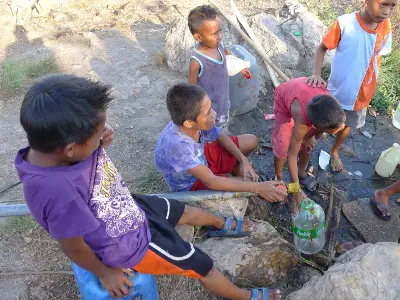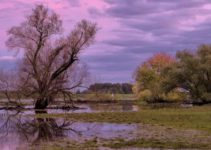One of the critical environmental issues that hound small islands is water scarcity. However, not only is the water scarce in such locations but also difficult to access, owing not only to environmental factors but also the attitude of people living on those islands. The experience of a community of fishers living in Nangalao Island is a case in point.
Impact Assessment
On April 30, 2013, I was one of a composite team of field workers who visited the island of Nangalao, about an hour boat ride from San Miguel poblacion in the municipality of Linapacan in Palawan Province. When the 20-passenger outrigger boat hit the shallows, we have to transfer to a smaller boat towed to the beach by a local fisher until we can step out right to the sand and avoid getting wet.
We have to duck through ropes and wires strung across rows of randomly built houses which occupy most of the beach front. The local government has no zoning scheme so the buildings and houses were in disarray. We have to snake our way through to get to the barangay hall.
My main concern in visiting the place was to assess the impact of a foundation’s various programs implemented in the community for the past six years. The main goal of those programs is to help uplift the living condition of the marginalized fisherfolks whose fishing activities have been affected by the operation of a natural gas project.
What caught my attention was a lady carrying a pail of water across the basketball court, in such a hurry and in an attempt to avoid bumping into teenagers playing on one side of the court. Thereafter, I saw another group of people carrying plastic containers from the same place the lady appeared. Obviously, they were fetching water from a nearby source.
Network of Water Pipes
This observation puzzled me because I have seen a network of large, black PVC water pipes at the left side of the barangay hall. I asked one of the local government officials to verify if indeed those pipes were intended to distribute water. As expected, he affirmed but noted that those pipes were empty because water flow from source was so weak to fill those pipes for household use.
I thought I would visit the water source to confirm. I asked for a guide to accompany me to the site, which, I discovered, lies two kilometers away.
Water availability is a very important factor to consider when evaluating the productivity of communities. Without water, it will be difficult for people to grow crops and of course, drink clean water to quench their thirst, among other household requirements. How can life be sustained without water?
Thus, I decided to walk all the way to the water source located uphill. That will also be good exercise for me after a few days out of my regular running routine.
The Water Source
The residents obtained water from two sources: one located about a kilometer away from the main cluster of houses, and the other nestled almost on top of a barren hill. My guide, together with another field worker, climbed up the rugged and steep hill devoid of vegetation. A recent fire razed dry cogon grasses (Imperata cylindrica) including a section of the PVC pipes which once funneled water downhill.
What we saw was a surprising, and pitiful scene. Young boys wait patiently for their turn to fill small water containers, with just a stream of water akin to that of a urinating animal. What can you expect in a bald mountain with rocky substrate that cannot hold much water?

Quarrel on Water Use
We saw a round, cement cistern located a few meters from the fetching area. I climbed by the side wanting to know how much water was in store. I saw the same stream of water from another pipe embedded on the side of the hill barely kept up with water drawn from it.
During rainy days, local folks say the cistern is almost full. Then I said, they don’t need to walk all the way then to the main source.
At that point, the guide told me that this was the situation before. The water pipes had already supplied the water needs of the underlying houses several years back. But residents living next to pipes in the upper elevations diverted the flowing water into their farms. They punched holes in the exposed plastic tubes and got the water for free. As a result, very little water trickled down the line. There were altercations between affected parties. Ultimately, the barangay chairman decided to stop operating the local government’s water services.
Now, everyone took the brunt of the decision. Not only is the water scarce but a natural resource of contention. Access to it is difficult and time consuming (see Opportunity Cost).
If you are a consultant for community development, what would you recommend?
© 2013 July 13 P. A. Regoniel


